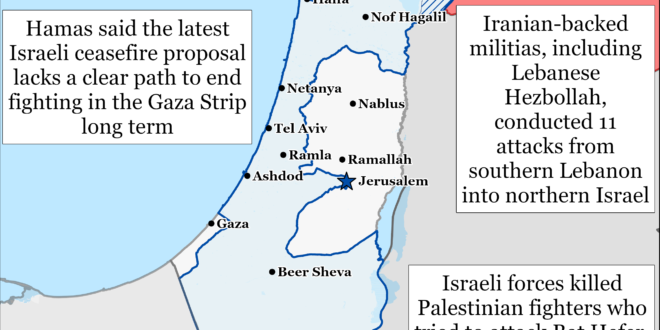A senior Hamas official responded negatively on June 4 to the latest Israeli ceasefire proposal for the Gaza Strip. Hamas appears unlikely to accept a proposal that does not meet the maximalist demands that Hamas has maintained since December 2023. Hamas Political Bureau member Osama Hamdan said Hamas cannot agree to a proposal that does not guarantee a permanent ceasefire, the complete withdrawal of Israeli forces from the Gaza Strip, and a hostage-for-prisoner exchange.[i] Hamdan called on international mediators to obtain a clear Israeli commitment to these demands. Hamdan added that all Palestinian factions share Hamas’ position. Hamas remains confident that it will survive Israeli military operations in the Gaza Strip and can therefore maintain its maximalist demands without granting major concessions.
The current Israeli proposal provides provisions to meet Hamas’ demands but does not guarantee them. An anonymous Israeli official told Israeli media that “there will not be a better offer” than the current Israeli proposal that Hamas is reviewing.[ii] US President Joe Biden outlined the three phases of the proposal as follows:[iii]
Phase one involves a six-week ceasefire and the withdrawal of Israeli forces from densely populated areas in the Gaza Strip. Hamas would release an unspecified number of hostages,
including Americans, women, and elderly and sick individuals, as well as the bodies of hostages in exchange for “hundreds” of Palestinian prisoners in this phase. Displaced Palestinian civilians would return to their homes, including those in the northern Gaza Strip. Humanitarian aid would “surge with 600 trucks [entering the Gaza Strip] per day” as well. Negotiations for a permanent ceasefire would continue during this phase.
Phase two involves Hamas and other Palestinian militias releasing all remaining living hostages and Israeli forces withdrawing from the Gaza Strip completely. Biden said that the United States, Egypt, and Qatar would ensure that negotiations continue during this phase.
Phase three involves major reconstruction efforts in the Gaza Strip. It also involves Hamas and the other militias returning the bodies of all hostages to Israel.
Axios reported that some Israeli officials are concerned that recent remarks from Israeli Prime Minister Benjamin Netanyahu could disrupt ceasefire negotiations.[iv] Netanyahu stated that Israel will not agree to a ceasefire until Hamas is destroyed.[v] Some Israeli officials are concerned that these comments could signal to Hamas that Israel only wants a temporary pause in the fighting rather than a permanent ceasefire.[vi] The proposal includes two clauses with vague language that would allow both sides to begin the first phase of the deal and progress into phase two as long as talks persist.[vii] Axios noted that the ambiguous phrasing could allow fighting to resume after the first phase without meaningful progress toward an end to the war.[viii] Netanyahu has said that he wants to retain the option to resume fighting should negotiations falter and that Israel could initiate the first phase of the ceasefire proposal without a follow-on agreement for a permanent ceasefire, according to Israeli media.[ix]
US President Joe Biden said on June 3 that Hamas is the only obstacle to a ceasefire in the Gaza Strip.[x] Biden told the Qatari emir that Israel is ready to initiate the ceasefire deal. Biden also said in an interview with Time that the Israeli proposal was “very generous” regarding which Palestinian prisoners Israel would release in exchange for Hamas-held hostages.[xi] The Qatari Foreign Affairs Ministry spokesperson said on June 4 that Qatar has delivered the latest Israeli proposal to Hamas.[xii]
Kataib Hezbollah, which is a prominent Iranian-backed Iraqi militia, called for a boycott of US businesses in Iraq and implied support for recent attacks targeting these businesses.[xiii] KH spokesperson Abu Ali al Askari called for the boycott in a statement on June 3. Askari accused US businesses of working as fronts for US intelligence services. Askari’s statement comes amid a series of attacks on US and UK companies in Iraq in recent days. Unidentified assailants have stormed and thrown explosives at these businesses, including Kentucky Fried Chicken (KFC) restaurants. damaging and vandalizing their property.[xiv] Local reporting claims that some of the assailants are KH members.[xv]
Askari separately called on Iraqi security forces personnel to refuse to comply with US instruction in operations against the so-called “Islamic State” (IS). US advisory forces under Operation Inherent Resolve advise Iraqi security forces on air operations, intelligence, logistics, planning, and targeting through the Joint Operations Command.[xvi] The US Defense Department has said that Iraqi security forces rely on US support for counter-IS operations.[xvii] Iraqi security forces personnel refusing to follow US instruction would undermine combined US-Iraqi counterterrorism operations.
Senior officials tied to the Islamic Revolutionary Guards Corps (IRGC) are supporting Iranian Parliament Speaker Mohammad Bagher Ghalibaf in the Iranian presidential election. Iranian media reported on June 4 that former IRGC Commander Mohsen Rezaei and Interim President Mohammad Mokhber recently met with Ghalibaf and expressed support for his candidacy.[xviii] Their backing alleviated Ghalibaf’s “doubts” about running, according to the Iranian reports.[xix] The Telegraph similarly reported that IRGC factions, including former IRGC Air Force Commander Hossein Dehghan, are supporting Ghalibaf.[xx] Dehghan is currently a senior adviser for defense industrial policy to the Iranian supreme leader. The Telegraph reported that individuals close to Dehghan ”are contacting everyone they know” to improve Ghalibaf’s chances. Ghalibaf—like Rezaei and Dehghan—is himself a former IRGC commander. Ghalibaf headed the IRGC Air Force from 1997 to 2000. He also has deep personal ties dating back to the Iran-Iraq War to many senior officers in the Iranian security establishment.[xxi]
Ghalibaf and other prominent figures are apparently focused on preventing Saeed Jalili in particular from winning the election. The Telegraph reported that some IRGC factions are trying to prevent Jalili from winning because they consider him too extreme politically.[xxii] Jalili serves as one of Supreme Leader Ali Khamenei’s personal representatives to the Supreme National Security Council (SNSC) and was the SNSC secretary from 2007 to 2013. A former official from the Iranian Interior Ministry told the Telegraph that individuals close to Ghalibaf oppose Jalili and “are contacting everyone they know to block Jalili.” An Iranian opposition outlet similarly reported in May 2024 that elements in the regime tried to convince Khamenei to prevent Jalili from competing in the election.[xxiii] These elements included Ghalibaf as well as other hardliners, such as Expediency Discernment Council Chairman Sadegh Amoli Larijani and senior adviser to the supreme leader Ali Shamkhani. These elements also included some moderates, such as Ali Larijani, who is the brother of Sadegh.
Ghalibaf and Jalili were previously at odds during the Mahsa Amini protest movement in Iran in late 2022. Ghalibaf accused Jalili of adopting too harsh a stance vis-a-vis the protests and exacerbating frustrations among disaffected Iranian youth.[xxiv] Ghalibaf contrastingly called for limited economic and political reforms to address protester grievances. Ghalibaf could use this contrast to appeal to more moderate elements in the Iranian political establishment.
Two factions from the Ebrahim Raisi administration are vying for the Iranian presidency, according to Iranian media.[xxv] These factions revolve around Culture and Islamic Guidance Minister Mohammad Esmaili and Roads and Urban Development Minister Mehrdad Bazrpash, both of whom registered as candidates for the election. Esmaili’s faction includes Planning and Budget Organization Director Davoud Manzour and Cooperatives, Labor, and Social Welfare Minister Solat Mortazavi. Bazrpash’s faction includes Martyrs and Veterans Affairs Foundation President Amir Hossein Ghazi Zadeh Hashemi.
Key Takeaways:
- Gaza Strip: A senior Hamas official responded negatively to the latest Israeli ceasefire proposal for the Gaza Strip. Hamas appears unlikely to accept a proposal that does not meet the maximalist demands that Hamas has maintained since December 2023.
- Iraq: A prominent Iranian-backed Iraqi militia called for a boycott of US businesses in Iraq and implied its support for recent attacks targeting these businesses.
- Iran: Senior officials tied to the IRGC are supporting Iranian Parliament Speaker Mohammad Bagher Ghalibaf in the Iranian presidential election.
- West Bank: Palestinian militias have continued trying to attack and threaten Israeli towns adjacent to the West Bank.
- Yemen: The Houthis announced that they recently fired a ballistic missile from Yemen toward Israel.
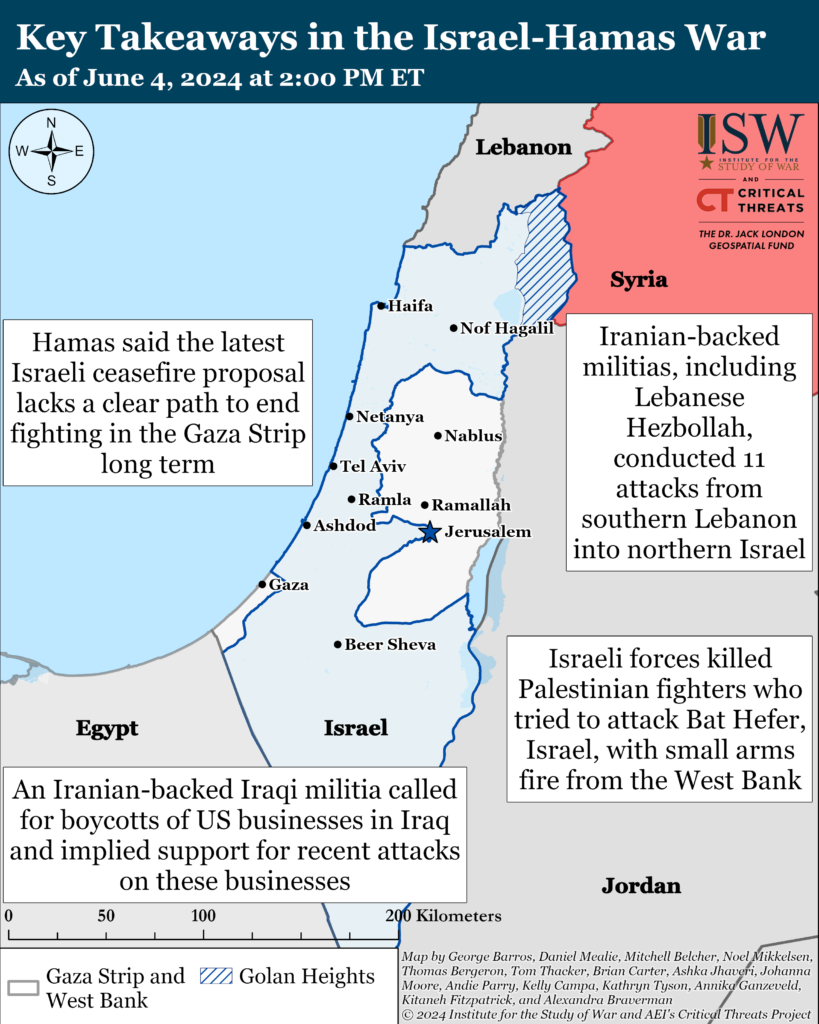
Gaza Strip
Axis of Resistance objectives:
Erode the will of the Israeli political establishment and public to sustain clearing operations in the Gaza Strip
Reestablish Hamas as the governing authority in the Gaza Strip
The Israel Defense Forces (IDF) stated on June 4 that it concluded its raid in southern Gaza City.[xxvi] The IDF announced on June 1 that it was conducting a raid into Sabra and Zaytoun neighborhoods of Gaza City with two brigades.[xxvii] The IDF 679th Brigade demolished during the raid a 1.5-kilometer-long and 23-meter-deep tunnel that Hamas fighters had used to attack Israeli forces.[xxviii] An Israeli military correspondent reported on June 4 that Israeli forces have withdrawn from Sabra back to the Netzarim Corridor.[xxix] The IDF 99th Division is currently operating along the Netzarim corridor, which the IDF uses to facilitate raids targeting Hamas fighters and militia infrastructure in the northern and central Gaza Strip.[xxx] Palestinian militias fired mortars at Israeli forces and an IDF site along the Netzarim Corridor.[xxxi]
The IDF said on June 4 that it launched a re-clearing operation targeting Hamas in Bureij in the central Gaza Strip.[xxxii] The IDF Air Force conducted airstrikes in Bureij to shape the terrain for follow-on ground operations.[xxxiii] The IDF Air Force struck a school compound, where it said that Hamas fighters were planning attacks targeting Israel and Israeli forces in the strip.[xxxiv] Locals in Bureij have reported several airstrikes in Bureij and nearby Maghazi refugee camp in recent days.[xxxv] Hamas mortared Israeli forces advancing east of Bureij.[xxxvi] The IDF initially advanced into Bureij in December 2023, isolating Hamas’ local battalion there.[xxxvii] The continued activity in Bureij reflects that Palestinian militias remain combat effective there. Hamas has exploited the fact that Israeli forces do not consistently isolate and reduce Palestinian militias during clearing operations. Hamas retains a presence around Bureij in part because its fighters probably move into areas that Israeli forces are not actively clearing to preserve Hamas combat strength and facilitate later reconstitution efforts.
The IDF continued clearing operations in Rafah on June 4.[xxxviii] Israeli forces located weapons in the area. A Palestinian journalist reported that Israeli forces advanced further into western Rafah.[xxxix] Palestinian militias claimed attacks targeting Israeli forces in central Rafah.[xl]
CIA Director Bill Burns and US National Security Council official Brett McGurk are traveling to Egypt and Qatar to advance the latest Israeli ceasefire proposal.[xli] Two US officials told the Times of Israel that the pair may also stop in Israel.
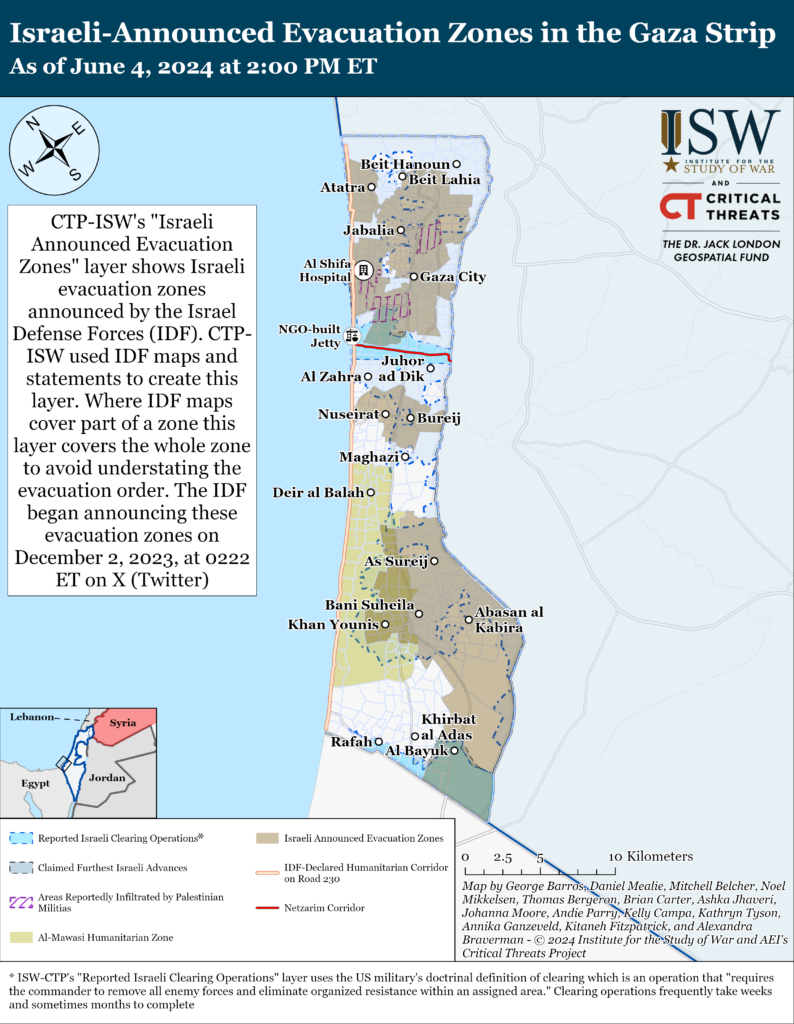
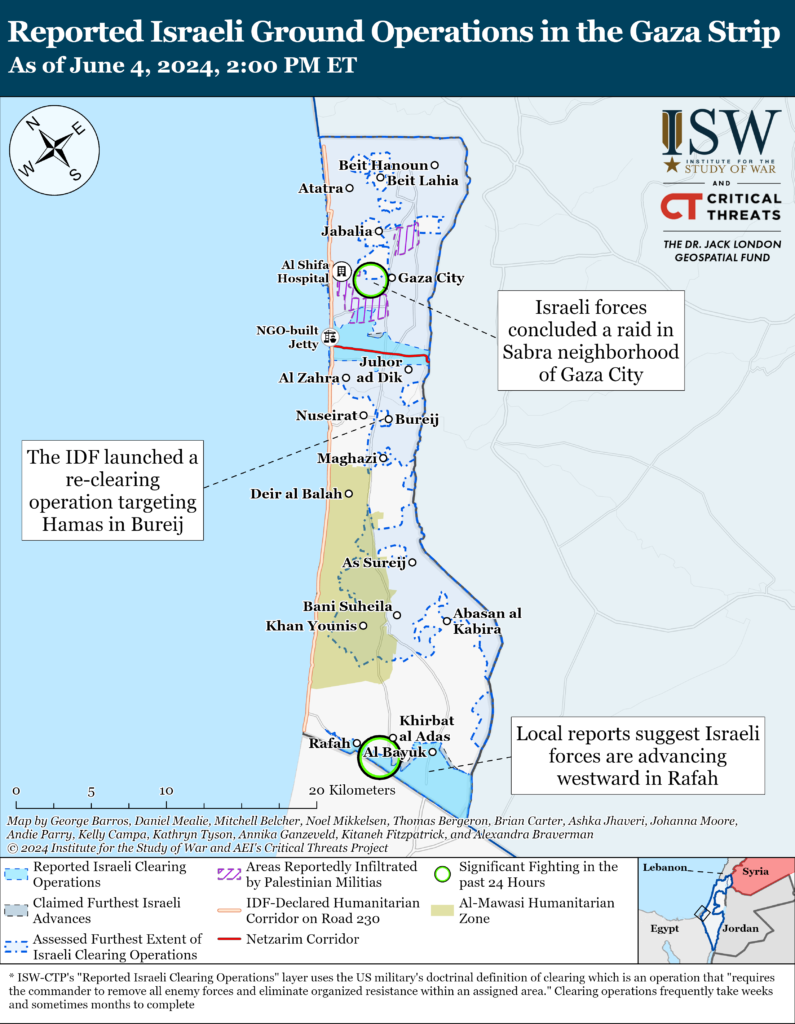
The Palestinian Mujahideen Movement fired rockets into southern Israel on June 4.[xlii]
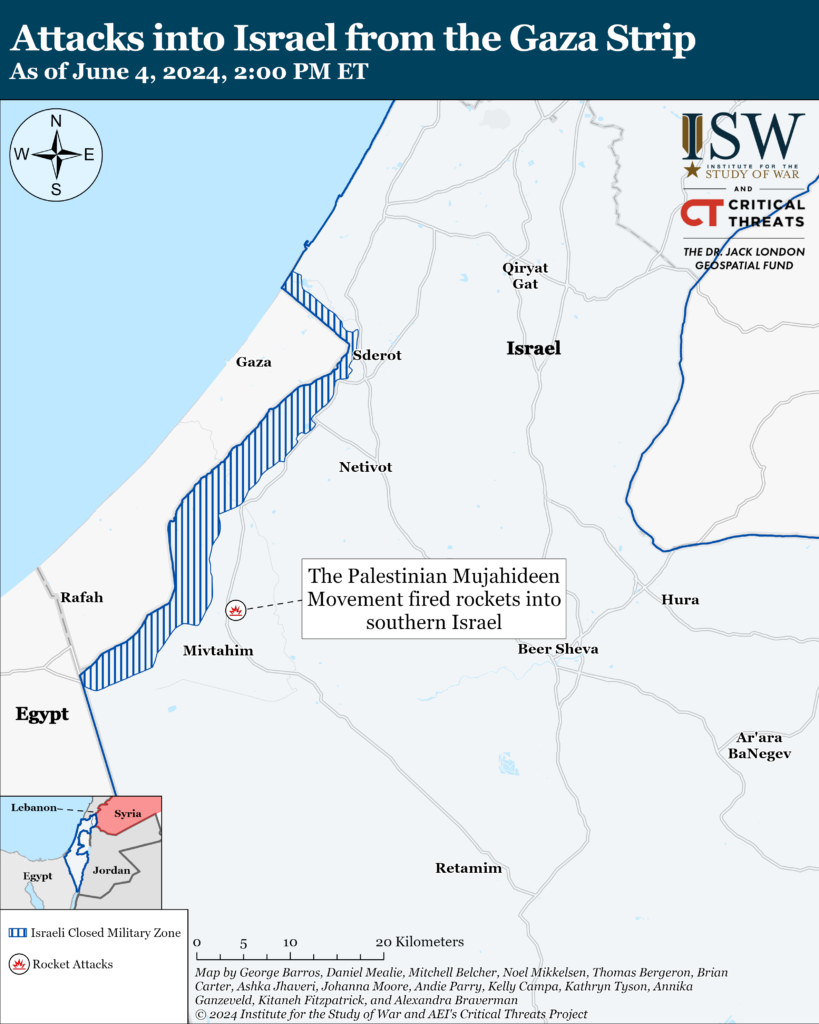
Recorded reports of attacks; CTP-ISW cannot independently verify impact.
West Bank
Axis of Resistance objectives:
Establish the West Bank as a viable front against Israel
Israeli forces have engaged Palestinian fighters in at least five locations in the West Bank since CTP-ISW’s last data cut off on June 3.[xliii]
Palestinian fighters continue to threaten Israeli towns from the West Bank. The IDF reported that two Palestinian fighters approached the border wall between Israel and Tulkarm on June 3 to shoot at Bat Hefer, Israel.[xliv] The IDF killed the two Palestinian fighters and confiscated their weapons.[xlv] Hamas and the al Aqsa Martyrs’ Brigades posted tributes to the two fighters.[xlvi] Both of the militias have claimed three separate attacks targeting Bat Hefer in recent weeks.[xlvii] CTP-ISW has previously reported that Palestinian militias in the West Bank maintain cells focused on attacking Israeli towns and cities outside the West Bank.[xlviii]
Israeli Defense Minister Yoav Gallant said on June 4 that the IDF will equip and train “intervention teams” of Israeli residents to respond to security incidents along the Tulkarm border with Israel.[xlix] Gallant conducted a situational assessment in Tulkarm.[l] Gallant said that the IDF will continue to conduct ground and air-based operations to thwart Iranian efforts to “flood” the West Bank with smuggled weapons.[li] Gallant instructed the IDF and the Israeli Defense Ministry to form, equip, and train “intervention teams” from Israeli towns and combat unit graduates to intervene in events that may develop along the Tulkarm border and in the region.[lii] Gallant did not say when these intervention teams would be established.

This map is not an exhaustive depiction of clashes and demonstrations in the West Bank.
Southern Lebanon and Golan Heights
Axis of Resistance objectives:
Deter Israel from conducting a ground operation into Lebanon
Prepare for an expanded and protracted conflict with Israel in the near term
Expel the United States from Syria
Iranian-backed militias, including Lebanese Hezbollah, have conducted at least 11 attacks into northern Israel since CTP-ISW’s last data cutoff on June 3.[liii] The IDF intercepted one drone launched from Lebanese territory over the coast of Nahariyya in northern Israel.[liv] An Israeli Army Radio correspondent reported on June 2 that the IDF is working to improve technological and defensive capabilities to resolve challenges intercepting drones targeting northern Israel.[lv] Hezbollah separately launched a ”squadron” of one-way attack drones targeting an IDF brigade in the Golan Heights.[lvi]
IDF Chief of Staff Lieutenant General Herzi Halev said on June 4 that Israel is approaching a point where it must decide how to respond to Hezbollah’s daily cross-border attacks.[lvii] Halevi said that Israeli forces on the northern border have been training and developing capabilities in preparation for an unspecified attack targeting Hezbollah.
Hezbollah Deputy Secretary General Naim Qassem said that Hezbollah is prepared for a war with Israel.[lviii] Qassem added that Hezbollah would respond to any Israeli attack “with devastation, destruction, and displacement.” He claimed that Hezbollah is currently only using a ”small portion” of its capabilities. Qassem reiterated that Hezbollah’s calculations on the Israel-Lebanon border are tied to Israeli activity in the Gaza Strip.

Recorded reports of attacks; CTP-ISW cannot independently verify impact.
Iran and Axis of Resistance
Houthi spokesperson Yahya Saree confirmed on June 3 that the Houthis recently launched a ballistic missile targeting Israel.[lix] Saree claimed that this attack was the first time the Houthis used the “Palestine” ballistic missile against Israel. The IDF intercepted a surface-to-surface ballistic missile over Eilat on June 3.[lx]
Acting Iranian Foreign Affairs Minister Ali Bagheri Kani traveled to Lebanon and Syria to coordinate with the rest of the Axis of Resistance, marking Bagheri Kani’s first travel abroad since becoming the acting foreign minister.[lxi] Bagheri Kani’s visit to Beirut focused at least partly on coordinating a response to the latest Israeli ceasefire proposal for the Gaza Strip. Bagheri Kani met with senior Palestinian militia officials, including officials from Hamas and Palestinian Islamic Jihad (PIJ), in Beirut on June 3.[lxii] Hamas Political Bureau member Khalil al Hayya and PIJ Secretary General Ziyad al Nakhalah attended the meeting. Bagheri Kani warned Israel during a press conference in Beirut not to attack Lebanon.[lxiii] Bagheri Kani separately met with Lebanese Hezbollah Secretary General Hassan Nasrallah on June 4.[lxiv] They discussed the latest Israeli ceasefire proposal for the Gaza Strip.
Bagheri Kani later traveled to Damascus and met with Syrian President Bashar al Assad on June 4.[lxv] Bagheri Kani called Iran and Syria ”two essential pillars of stability and security in the region” during a press conference with Syrian Foreign Affairs Minister Faisal Mekdad.[lxvi] Bagheri Kani separately met with unspecified senior Palestinian militia officials in Syria.[lxvii] Iranian Ambassador to Syria Hossein Akbari attended the meeting.
Representatives of ten unspecified Palestinian groups traveled to Tehran on June 4 to participate in the 35-year anniversary ceremony for former Iranian Supreme Leader Ruhollah Khomeini’s death.[lxviii] Secretary General of the Palestine Conference Mojtaba Abtahi emphasized that Hamas’ October 7, 2023, attack caused a shift in the balance of power in the region.
A senior Iranian official threatened that Iran respond in some unspecified way if the International Atomic Energy Agency (IAEA) approves a censure resolution against Iran. Atomic Energy Organization of Iran Director Mohammad Eslami made the remark on June 4.[lxix] The United Kingdom, France, and Germany submitted to the IAEA Board of Governors on June 3 a draft censure resolution that condemns Iran for not cooperating fully with the IAEA.[lxx] IAEA Director General Rafael Grossi recently expressed concern about the Iranian nuclear program after visiting Tehran from May 6 to 8, stating that Iranian cooperation with the agency is “not at the level it should be.”[lxxi] The IAEA Board of Governors last passed a censure resolution against Iran in November 2022, after which Iran increased its enrichment of uranium.[lxxii]
 Eurasia Press & News
Eurasia Press & News
